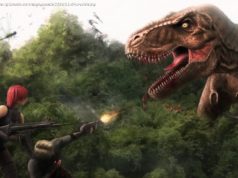There are two
Time for a quick philosophical riddle: If a superhero movie doesn’t include post-credits scenes teasing what’s to come, does it really exist?
[ Warning: The following contains spoilers for Justice League.]
Justice League, which is now out in theaters, has two post-credits scenes, but only one really needs to be explained. The first scene, which takes place about a third of the way through the credits, is a goofy moment shared by a resurrected Superman and Flash. It calls back to an earlier scene in the movie when Flash and Superman are racing to save a group of civilians trying to escape the battleground Steppenwolf and his parademons have taken over.
The post-credits scene pits Flash against Superman as they race from the middle of nowhere to the West Coast, proving once and for all who’s the faster superhero. The banter between the two and their obvious mutual admiration is indicative of everything Justice League does right. The tone is lighthearted, the callback jokes are used well and it gives us better insight into these small bonding moments between the team.
Related
The Flash is Justice League’ s standout character, and it’s heartwarming to see him get his due. He and Superman have an interesting dynamic, like brothers, which makes their interactions a little more enjoyable to watch than Batman and Flash, who share a much more father-son dynamic. The post-credits scene is further proof that Flash will continue to play a big role in the Justice League, akin to what Spider-Man is sure to become in the Avengers.
The second post-credits scene, however, needs to be broken down and explained.
Lex Luthor, played by Jesse Eisenberg, has escaped from prison. He’s sitting on a yacht somewhere in Europe, waiting. A masked man appears on the ship, standing in front of Luthor as the criminal mastermind talks about his return to the limelight, preparing to take on the newly minted Justice League.
The masked figure is Deathstroke, who will make his full, feature-length debut in Matt Reeves’ stand-alone Batman movie, The Batman. Deathstroke’s costume may evoke comparisons to Ryan Reynolds’ Deadpool, but Deathstroke preceded Deadpool by more than a decade in the comics. In fact, Deadpool was a deliberate ripoff of Deathstroke. Still, this is one of the first times we’ve seen the master mercenary and assassin (again, like Deadpool) on the big screen. Slade Wilson (Deadpool’s name is Wade Wilson) made his comics debut in The New Teen Titans (vol. 1) issue #2 in 1980. Deathstroke was conceived as an enemy of the Teen Titans, but as his presence in DC Comics expanded, he battled other heroes, including Batman.
Deathstroke, played by a white-haired and white-bearded Joe Manganiello, doesn’t say much, but it’s evident that he’s ready to help Luthor destroy the Justice League. His intentions aren’t clear, but it makes sense we’d learn more about those in The Batman. The most interesting part of their conversation comes at the very end, when Luthor suggests it’s time for these villainous figures to form a “league of our own.”
This could reference a number of possibilities for the hero, but Deathstroke was a founding member of Lex Luthor’s Secret Society of Super Villains, but DC’s villain team ups have so little long-standing identity that the exact name of the alliance (the Injustice League, the Anti-Justice League, the Brotherhood of Evil) could be almost anything. In any case, if DC Comics and Warner Bros. wants to create a league of real bad guys — that aren’t on the C-list, like the Suicide Squad — this would be one way to do it.
The scene promises bigger battles between the Justice League and some kind of evil organization, but without additional details it’s hard to determine what that looks like. At this point, we don’t even know if there will be a second Justice League movie, but we’re working under the assumption that DC Comics and Warner Bros. will continue to build their superhero universe. Whatever happens, we know that Deathstroke and Luthor will be involved.
Justice League is now in theaters.






